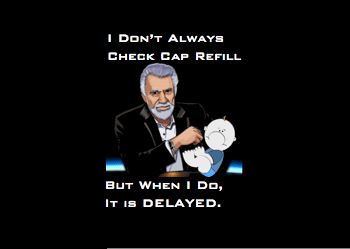Capillary Refill & Shock

Shock: Pediatric Sepsis
- Significant cause of Non-traumatic childhood mortality in the USA. [Osterman, 2015]
- When recognized early and treated aggressively, morbidity and mortality can be decreased by 50%. [Han, 2003]
- Definition of pediatric SIRS differs from adult definition in that at least one diagnostic criteria must be fever or hypothermia. [Prusakowski, 2017]
- SIRS Criteria (2 of the following, with one being fever/hypothermia)
- Fever or Hypothermia (>38.5 degrees Celsius or <36 degrees Celsius.)
- Tachycardia
- No criterion to adjust for tachycardia in the presence of fever.
- Tachypnea
- Leukocytosis or Leukopenia (abnormal for age)
- Bandemia (>10% immature neutrophils)
- Sepsis, as with adults, requires the patient have SIRS criteria AND a known or suspected infection (bacterial or viral).
- Septic Shock is Sepsis with cardiovascular dysfunction (tachycardia/bradycardia AND impaired perfusion).
Kid Physiology to Consider
- Infants and young children have a greater proportional amount of extracellular fluid to intracellular fluid compared to adults. [Prusakowski, 2017]
- Predisposes them to more risk with decreased fluid intake or excessive fluid losses.
- Young children cannot increase their myocardial contractility. [Prusakowski, 2017]
- Heart is already functioning at a high contractile state.
- In order to increase Cardiac Output, kids have to increase heart rate.
- The younger the child, though, the higher the baseline HR is, and the less likely increased cardiac output can be achieved solely with increasing the heart rate.
- This is why vasopressors and/or inotropes may be beneficial for fluid-refractory shock in kids.
- Cold Shock is more likely in children then adults.
Shock: Recognition
- There is no single pathognomonic finding that defines shock.
- Hypotension is a late finding, but an ominous one, in kids.
- Constellation of findings:
- Tachycardia
- Tachypnea
- Poor perfusion
- Poor pulse quality
- Altered mental status
- Cold Shock findings:
- High Systemic Vascular Resistance
- Cold, clammy, mottled, or cyanotic extremities
- Capillary Refill > 2 seconds
- Diminished / thready pulses
- Narrow pulse pressure.
- Respect the “just ain’t right” findings:
- Poor feeding
- Jittery
- Irritable
- Lethargic
Be Aggressive Early
- Once recognized, be aggressive within 1st hour!
- IV or IO 40-60 ml/kg of isotonic fluids PUSHED rapidly
- Optimize oxygenation
- Supplemental may be all that is initially needed.
- 30-40% of a child’s cardiac output goes to the work of breathing when critically ill, so often will require additional support (i.e., intubation).
- Broad spectrum antibiotics
- Press the Pressors!
- Fluid-refractory shock is present if the patient, after 40-60 ml/kg, is hypotensive or has poor perfusion.
- Fluid-refractory shock should be treated with vasopressors via peripheral IV or IO.
- Ideally, they would be given via central line…
- The ED is, however, NOT an ideal environment…
- So start them peripherally and plan to change to central line once time permits.
Moral of the Morsel
- Shock is difficult to recognize and requires vigilance! Pay attention to capillary refill!
- Be aggressive early! Push the fluids in, don’t hang to gravity.
- Respect what the skin is telling you! Monitor the capillary refill time. If it is still prolonged after IV boluses, treat it like refractory shock.
References
Prusakowski MK1, Chen AP2. Pediatric Sepsis. Emerg Med Clin North Am. 2017 Feb;35(1):123-138. PMID: 27908329. [PubMed] [Read by QxMD]
Fitzgerald JC1, Weiss SL, Kissoon N. 2016 Update for the Rogers’ Textbook of Pediatric Intensive Care: Recognition and Initial Management of Shock. Pediatr Crit Care Med. 2016 Nov;17(11):1073-1079. PMID: 27749512. [PubMed] [Read by QxMD]
Osterman MJ1, Kochanek KD2, MacDorman MF2, Strobino DM3, Guyer B3. Annual summary of vital statistics: 2012-2013. Pediatrics. 2015 Jun;135(6):1115-25. PMID: 25941306. [PubMed] [Read by QxMD]
Dellinger RP1, Levy MM, Rhodes A, Annane D, Gerlach H, Opal SM, Sevransky JE, Sprung CL, Douglas IS, Jaeschke R, Osborn TM, Nunnally ME, Townsend SR, Reinhart K, Kleinpell RM, Angus DC, Deutschman CS, Machado FR, Rubenfeld GD, Webb S, Beale RJ, Vincent JL, Moreno R; Surviving Sepsis Campaign Guidelines Committee including The Pediatric Subgroup. Surviving Sepsis Campaign: international guidelines for management of severe sepsis and septic shock, 2012. Intensive Care Med. 2013 Feb;39(2):165-228. PMID: 23361625. [PubMed] [Read by QxMD]
Han YY1, Carcillo JA, Dragotta MA, Bills DM, Watson RS, Westerman ME, Orr RA. Early reversal of pediatric-neonatal septic shock by community physicians is associated with improved outcome. Pediatrics. 2003 Oct;112(4):793-9. PMID: 14523168. [PubMed] [Read by QxMD]



Link to “vasopressors” under Kids Physiology redirects to Acute Epididymitis. So that this can be fixed if unintentional.
THANK YOU!
It has been fixed.
🙂
[…] for signs of SHOCK and treat with Fluids and Pressors as […]
[…] and managing the child in SHOCK is certainly challenging. Identifying it (ex, Cap Refill, Shock Index, Lactate level) is challenging. Treating it is also challenging (see, Epi over Dopa). […]
[…] In order to provide superior care for all of the kids we see, we need to know the critical (ex, SHOCK, Difficult Airway, and Necrotizing Enterocolitis), the common (ex, Bronchiolitis, Asthma, and […]
[…] Fever in a neonate may be due to a virus, but we can’t bet on it. Fever in the patient with delayed cap refill requires more contemplation than what is the maximum dose of antipyretic. Fever in a patient with […]
Good work
[…] of their child and, certainly, the skin exam is a valuable tool for the vigilant clinician (ex, Cap Refill, Petechiae below Nipple Line, Leukemia, RMSF). That being said, the majority of pediatric rashes […]